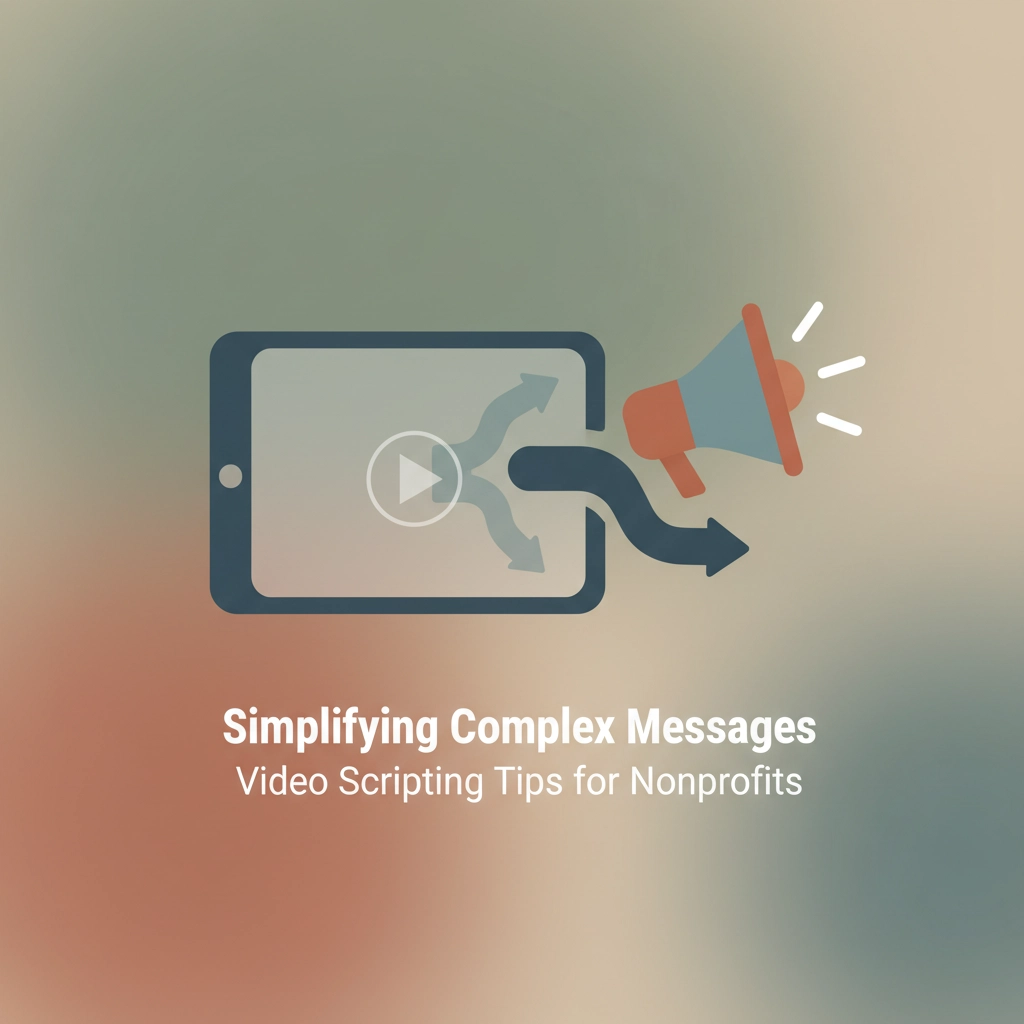Simplifying Complex Messages: Video Scripting Tips for Nonprofits

Picture this: You're sitting in a boardroom with your nonprofit's leadership team, staring at a script that reads like a doctoral thesis. Three pages of dense text trying to explain your organization's impact, complete with statistics, jargon, and enough buzzwords to make anyone's eyes glaze over. Sound familiar?
Here's the thing, if you can't explain what your nonprofit does in simple terms, your audience sure won't understand it either. And in today's world where attention spans are shorter than a Toronto streetcar delay, complex messaging is the fastest way to lose your audience before they even hit the donate button.
The good news? With the right scripting approach, you can transform even the most complex nonprofit mission into compelling, crystal-clear video content that actually moves people to action.
Why Nonprofits Struggle with Video Scripts
Let's be honest, nonprofit work is inherently complex. Whether you're tackling homelessness in Toronto, supporting mental health initiatives across Ontario, or working on Indigenous reconciliation, the issues you're addressing don't have simple solutions. But here's where many organizations get tripped up: they think complex problems require complex explanations.
Take the United Way of Greater Toronto, for instance. They could spend ten minutes explaining their community investment strategies, partnership frameworks, and outcome measurement protocols. Instead, their most effective videos focus on single, powerful stories, like how their school breakfast program helped one child succeed academically. Same impact, infinitely more engaging.

The challenge isn't that your work is too complicated to explain, it's that you're trying to explain everything at once. Your video script isn't a grant application or an annual report. It's a conversation starter, a door opener, a moment to make someone care enough to learn more.
Start with One Clear Message
Before you write a single word, ask yourself this: If someone watched your video and could only remember one thing, what would you want it to be?
This might sound overly simplistic, but it's the foundation of effective nonprofit video scripting. The Salvation Army doesn't try to explain their entire organizational structure in their fundraising videos, they focus on the simple message that everyone deserves a warm meal and a safe place to sleep.
Here's a practical exercise: Write your core message in one sentence using language a twelve-year-old would understand. If you can't do this, you're not ready to script your video yet. Go back to the drawing board and clarify what you're really trying to communicate.
Once you have that core message, everything else in your script should support it. Every statistic, every story, every visual element should reinforce that single, clear idea. Think of your script like a tree, your core message is the trunk, and everything else branches out from there.
The Magic of the 90-Second Rule
Want to know a secret? Most successful nonprofit videos are under 90 seconds long. That translates to roughly 150-200 words in your script when spoken at a natural pace of about 130-150 words per minute.
This isn't just some arbitrary rule, it's based on how people actually consume video content. Studies consistently show that viewer engagement drops significantly after the 90-second mark. In the nonprofit world, where you're often competing with cat videos and social media updates for attention, every second counts.

But here's where it gets interesting: this constraint actually makes your messaging stronger, not weaker. When you only have 90 seconds, you're forced to cut the fluff and focus on what truly matters. It's like editing a novel down to a short story, you keep only the most powerful, essential elements.
Look at how SickKids Foundation approaches this. Their most impactful videos don't try to explain their entire research portfolio or list every program they offer. Instead, they focus on one compelling story, a child's journey, a breakthrough moment, a family's hope, and let that story carry the emotional weight of their mission.
Tell Stories, Not Statistics
Here's where most nonprofits go wrong: they lead with data instead of humanity. Yes, your statistics are important, the fact that food banks in Ontario served over 587,000 people in 2023 is staggering and significant. But statistics don't move people to action. Stories do.
Instead of starting with numbers, start with a person. Instead of talking about "food insecurity affecting thousands of families," introduce us to Sarah, a single mother in Ottawa who works two jobs but still struggles to put dinner on the table for her kids.
This doesn't mean you should ignore your data, it means you should use it strategically. Weave statistics into your narrative to add credibility and scale to your story. After we meet Sarah, then you can reveal that she's one of thousands facing the same challenge across Ontario.
The Toronto Foundation does this beautifully in their community impact videos. They don't start with grant amounts or program statistics. They start with real people whose lives have been changed, a newcomer finding community, a student receiving a scholarship, a neighborhood garden bringing people together. The data comes later, as supporting evidence for the human story they've already made us care about.
Simplify Your Language (Seriously)
Every industry has its jargon, and the nonprofit world is no exception. But here's the thing, your audience doesn't live in your world of "stakeholder engagement," "capacity building," and "systems-level interventions." They live in the world of everyday language, where people want to help other people.

Instead of saying your organization "facilitates community-based programming to address systemic barriers to educational achievement," try "we help kids succeed in school." Instead of "leveraging cross-sector partnerships to maximize impact," say "we work with other organizations to help more people."
This isn't dumbing down your message, it's respecting your audience enough to speak their language. The Canadian Mental Health Association, Ontario has mastered this approach. They don't talk about "mental health literacy initiatives" or "evidence-based intervention strategies." They talk about helping people understand their feelings and find the support they need.
Use metaphors and analogies when helpful, but avoid getting too clever. Your goal is clarity, not creativity for its own sake. If a metaphor doesn't make your message clearer, cut it.
Test Your Script Before You Film
Here's a step most nonprofits skip: actually testing their script before production begins. You've spent weeks crafting the perfect message, but how do you know it actually works?
Read your script out loud to people who aren't familiar with your organization. Better yet, have someone else read it while you listen. Do they stumble over certain phrases? Do they naturally emphasize the points you want emphasized? Do they understand your core message without additional explanation?
The Boys and Girls Club of Canada regularly tests their messaging with focus groups before creating major video campaigns. They've learned that what sounds clear in a boardroom doesn't always translate to their target audience of parents and potential volunteers.
Get feedback from multiple perspectives, board members, staff, volunteers, and most importantly, people who represent your target audience. Don't just ask if they liked it, ask what they understood, what confused them, and what they would do after watching.
Make Every Word Count
With limited time and attention, every word in your script needs to earn its place. This means cutting redundancy, eliminating filler words, and being ruthless about unnecessary details.
Instead of "Our organization works really hard to try to help families in need across the Greater Toronto Area who are struggling with various challenges," try "We help struggling families in Toronto find stability and hope."

Watch for these common script-killers:
- Redundant phrases ("past history," "future plans")
- Weak qualifiers ("quite," "rather," "fairly")
- Unnecessary introductions ("What I'd like to talk about today is...")
- Industry jargon that adds no value
Remember, you can always provide more detail on your website or in follow-up materials. Your video's job is to create interest and inspire action, not to provide comprehensive information.
The Power of a Strong Call to Action
Your script needs to end with a clear, specific call to action. Don't just say "visit our website" or "get involved", tell people exactly what you want them to do and make it easy for them to do it.
"Visit northbrothersfilms.ca to learn how we can help tell your nonprofit's story" is better than "contact us for more information." "Text HOPE to 45678 to donate $10" is better than "please consider making a donation."
The most effective nonprofit videos create momentum that carries viewers directly to action. Your script should build toward this moment, making the call to action feel like a natural next step rather than an awkward afterthought.
Bringing It All Together
Creating effective nonprofit video scripts isn't about oversimplifying your important work: it's about respecting your audience enough to communicate clearly and compellingly. When you strip away the jargon, focus on one clear message, and lead with human stories, you create videos that don't just inform: they inspire.

Remember, your video is often the first impression people have of your organization. Make it count by keeping your message simple, your language clear, and your focus on the people you serve. Whether you're a small community organization in Thunder Bay or a major foundation in Toronto, these principles will help you create video content that truly connects with your audience.
The most successful nonprofits understand that clarity isn't the enemy of complexity: it's the bridge that helps people understand why your complex work matters. And when people understand why it matters, they're much more likely to support it.
Ready to transform your nonprofit's message into compelling video content? Our team at North Brothers Films specializes in helping organizations across Ontario tell their stories with clarity and impact. Let's work together to create videos that don't just explain your work: they inspire people to be part of it. Get in touch with us today and let's start crafting your story.
